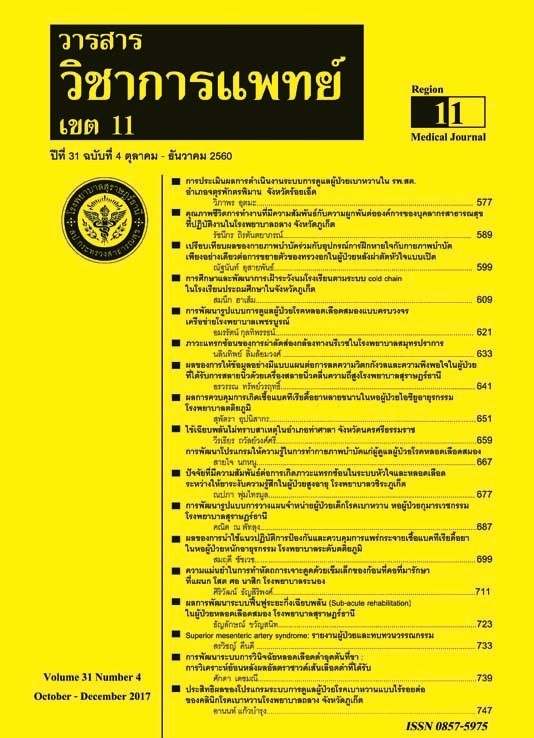Effect of Structured Health Education to decrease Anxiety and Satisfaction of Patient with Extra Corporeal Shock Wave Lithotripsy: ESWL) at Suratthani Hospital
Keywords:
Structured Health Education, Anxiety, Patient with Extra Corporeal Shock Wave LithotripsyAbstract
This control group pre-test post test designs was quasi-experimental research. The purpose of this research was to1)compare between Structured Health Education to decrease Anxiety of Patient with Extra Corporeal Shock Wave Lithotripsy(ESWL) at Suratthani Hospital and control group and 2) study satisfaction of Patient with Extra Corporeal Shock Wave Lithotripsy (ESWL) at Suratthani Hospital. The purposive sample were patient with Extra Corporeal Shock Wave Lithotripsy(ESWL) at Suratthani Hospital between April – August, 2017.The research instruments were manual of prepare for patient with ESWL. The ESWL manual was adjusted for appropriate and practically. Collected data by 1) personal data 2) Stage Anxiety : From X-I 3) Satisfaction questionnaires was tested for content validity and reliability with alpha coefficient of 0.71 The data were analyzed by using mean, standard deviation and pair t-test. The results revealed that:
1. Practice prepare for patient with ESWL manual, the mean score of anxiety on patient with ESWL was statistically significantly lower than the mean score of anxiety in the routine care patient (p < .05)
2. After the Practice prepare for patient with ESWL manual, mean score of satisfaction of Patient with Extra Corporeal Shock Wave Lithotripsy (ESWL) at Suratthani Hospital was higher level.(Mean = 4.37 ,SD=0.53)
References
2. โรคเกี่ยวกับระบบทางเดินปัสสาวะ. [อินเทอร์เน็ต]. 2560. [สืบค้นเมื่อวันที่ 15มีนาคม2560]; http://www.108health.com/108health/category.php?sub_id=59&ref_main_id=15
3. ธิมาภรณ์ ซื่อตรง, สุพรดนัย ดุษฎีกุล, นภาพร วาณิชย์กุล และตรีหาญ ประเสริฐพงษ์. (2559). เปรียบเทียบดัชนีมวลกายความเครียดเรื้อรังความแตกฉานทางสุขภาพความรับผิดชอบของผู้ป่วยและการรับรู้การดูแลแบบบุคคลเป็นศูนย์กลางระหว่างผู้ป่วยที่เป็นนิ่วในระบบทางเดินปัสสาวะซ้ำและผู้ที่ไม่เป็นซ้ำ. Journal of Nursing Science, 34(2):80-91.
4. ประวีณ ทับแสง. (2551). ต้นทุนค่าใช้จ่ายผลการรักษาและความพึงพอใจในการรักษาโรคนิ่วระบบทางเดินปัสสาวะส่วนบนโดยวิธีสลายนิ่วด้วยคลื่นช็อคเวฟในโรงพยาบาลมหาสารคาม. ขอนแก่นเวชสาร, 32(7) ฉบับพิเศษ: 1-11.
5. รายงานจำนวนผู้ป่วยของโรงพยาบาลสุราษฎร์ธานี. (2559). แผนกผู้ป่วยนอก. รายงานประจำปี.
6. Spielberger CD. (1972). Anxiety as an Emotional State. In CD. Spielberger (ed.) Anxiety and Behavior. New York: Academy.
7. Spielberger CD. (1976). The Nature and Measurement of Anxiety. In Spielberger CD. and Diaz-Guerrero R. (Eds.), Cross Cultural Anxiety. P. 3-10; Washington D.C. :Hemisphere.
8. Leventhal H. & Johnson JE. (1983). Laboratory and Field experiment ion; Development Of Theory of self-Regulation, In PJ. Wooldrige, MH,& Schmitt JK.
9. กุลถิรา ชินวัฒนา, เกศรา เสนงาม และสุภางค์พิมพ์ รัตสัมพันธ์. (2556). ผลของการให้ข้อมูลก่อนการ ตรวจต่อระดับความวิตกกังวลของผู้ป่วยโรคหัวใจที่ได้รับการตรวจคลื่นเสียงสะท้อนความถี่สูงผ่านหลอดอาหาร. เอกสารประกอบการประชุมวิชาการในโอกาสครบรอบ 25 ปีและการประชุมเสนอผลงานวิจัยระดับ Digital Multimedia ณ วิทยาลัยวิศวกรรมศาสตร์บัณฑิตศึกษาปีการศึกษา 2556.
10. ลิกิจ โหราฤทธิ์. (2551). ผลของการให้ข้อมูลเตรียมความพร้อมต่อความวิตกกังวลในผู้ป่วยที่ได้รับการผ่าตัดโรคระบบทางเดินอาหาร. วิทยานิพนธ์ปริญญาพยาบาลศาสตรมหาบัณฑิต สาขาพยาบาลผู้ใหญ่ คณะพยาบาลศาสตร์มหาวิทยาลัยขอนแก่น.






